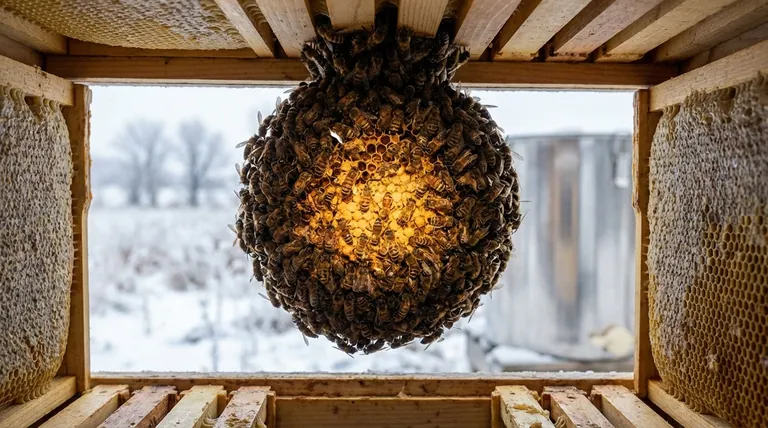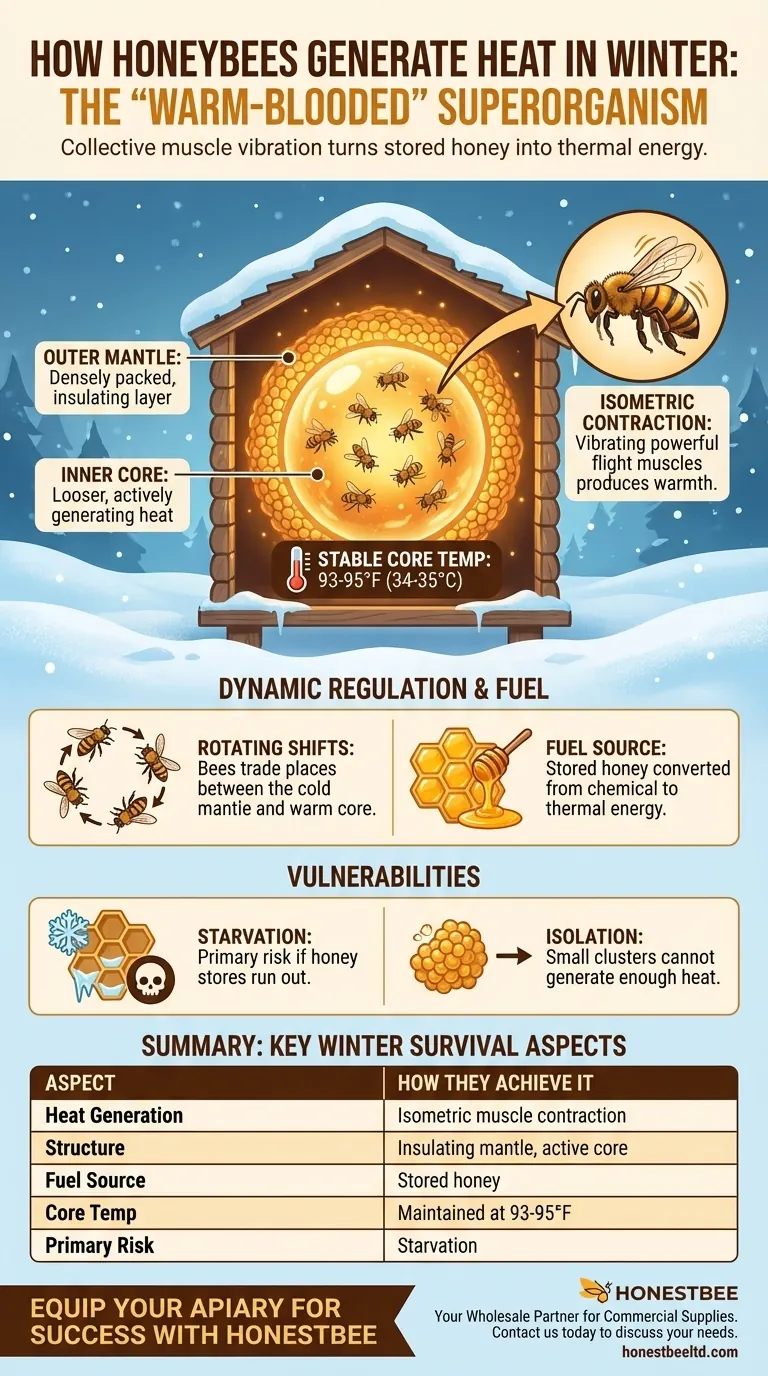In short, honeybees generate heat by forming a dense cluster and vibrating their powerful flight muscles. They uncouple their wings so this vibration, or isometric contraction, produces warmth without causing flight. This collective effort allows the colony to function as a warm-blooded superorganism, maintaining a stable core temperature even when it is freezing outside.
The key to honeybee winter survival is not resisting the cold, but creating their own climate. They achieve this by converting the stored chemical energy of honey into thermal energy through coordinated muscle work, behaving as a single, self-regulating entity.

The Winter Cluster: A Collective Furnace
A lone honeybee cannot survive freezing temperatures for long. The colony's survival depends entirely on its ability to work together to generate and conserve heat through a remarkable structure known as the winter cluster.
The Structure of the Cluster
The cluster is not a simple swarm but a highly organized, multi-layered sphere of bees. The outer layer forms a dense, insulating mantle where bees are packed tightly together, shielding the interior from the cold. The inside of the cluster is much looser, allowing bees to move and actively generate heat.
The Core of the Heat Generation
The real work happens inside the cluster. Bees engage in isometric contraction of their thoracic flight muscles. By essentially flexing these powerful muscles without moving their wings, they convert the chemical energy from honey directly into heat, warming themselves and the surrounding air.
The Fuel for the Fire: Honey
This intense muscular activity requires a massive amount of energy, which comes from their stored honey. The colony spends the spring and summer collecting nectar and converting it into honey precisely for this purpose. The winter cluster slowly moves upwards through the hive over the winter months, consuming these honey stores to fuel their "furnace."
Dynamic Temperature Regulation
Generating heat is only half the battle; the colony must also regulate it precisely. They maintain the core of the cluster, where the queen resides, at a stable 93-95°F (34-35°C), especially once she begins laying eggs in mid-winter.
A Precise Thermostat
The colony acts like a living thermostat. If the internal temperature drops, more bees inside the cluster begin vibrating to generate more heat. If it gets too warm, they slow their vibrations. The cluster can also expand or contract to adjust the ratio of heat loss to heat production.
Rotating Shifts
Bees on the cold, outer mantle do not stay there indefinitely. They systematically trade places with the warmer bees from the cluster's interior. This constant rotation ensures that no single group of bees bears the full brunt of the cold and allows all members of the colony to access food and contribute to heat generation.
Understanding the Vulnerabilities
While incredibly effective, this survival strategy has critical failure points. Understanding them reveals just how fragile the colony's existence is.
The Risk of Starvation
The primary threat to a wintering colony is not the cold itself, but starvation. If the honey stores run out, the furnace shuts down, and the bees will quickly freeze. A cluster can starve even with honey nearby if it becomes too cold for them to break formation and move to the food source.
The Danger of Isolation
A cluster that is too small cannot generate enough heat to survive. There is a critical mass of bees required to form an effective insulating mantle while having enough bees inside to produce the necessary warmth. This is why small, late-season swarms rarely survive their first winter.
Key Survival Factors for a Colony
The success of a honeybee colony's wintering effort hinges on preparation and collective action.
- If your primary focus is colony health (as a beekeeper): Ensure the hive has abundant honey stores and proper ventilation to allow moisture from the bees' respiration to escape.
- If your primary focus is biology (as a naturalist): Appreciate that the colony survives by functioning as a single "superorganism," where collective behavior overcomes individual limitations.
Ultimately, a honeybee colony survives winter not as thousands of individuals, but as one coordinated, heat-generating organism fueled by the work of the previous summer.
Summary Table:
| Key Aspect | How Honeybees Achieve It |
|---|---|
| Heat Generation | Isometric contraction of flight muscles (vibrating without flying) |
| Structure | Dense, insulating outer mantle with a warmer, active core |
| Fuel Source | Stored honey, converted from chemical to thermal energy |
| Core Temperature | Maintained at a stable 93-95°F (34-35°C) |
| Primary Risk | Starvation due to insufficient honey stores |
Equip Your Apiary for Success with HONESTBEE
A honeybee colony's survival depends on its collective strength and the resources it has stored. Your commercial beekeeping success depends on reliable, high-quality equipment and supplies. HONESTBEE is your trusted wholesale partner, supplying commercial apiaries and distributors with the essential tools for healthy, productive hives year-round.
From durable hive components to essential feeding supplements, we provide the infrastructure that supports the incredible natural processes of the bee colony. Let us help you build a stronger foundation for your business.
Contact HONESTBEE today to discuss your wholesale needs and ensure your operations are equipped for every season.
Visual Guide

Related Products
- Stainless Steel Honey Storage Tank with Lid for Honey
- Plastic Honey Comb Frames Cassette Box for Honey
- Stainless Steel Honey Tank Stand for Honey Storage
- Professional Insulated Plastic Bee Hives
- Langstroth Honey Bee Box Hive Boxes for Different Depths
People Also Ask
- How long should honey settle in settling tanks? The 48-Hour Rule for Perfect Clarity
- What is the purpose of a honey storage tank? Streamline Your Honey Processing for Quality & Efficiency
- Which container is best for storing honey? Preserve Purity & Flavor with the Right Choice
- What is the optimal temperature for honey crystallization? Control Texture for Liquid or Creamed Honey
- How long to leave honey in a settling tank? Optimize Your Clarification Process



















